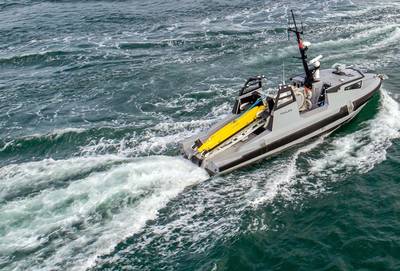UK Royal Navy Testing Crewless Minehunter
The U.K. Royal Navy said it is testing a new crewless minehunter as part of its drive toward autonomous systems.
Developed through a joint Anglo-French Maritime Mine Counter Measures program, the system is designed to detect the latest mine threats while reducing the risk to the lives of those searching for them. It comprises an uncrewed surface vessel, towed sonar and a portable operation center, and is now undergoing rigorous capability development trials.
Demonstrators have been delivered to both the Royal and French Navies, the U.K. model handed over in Plymouth by Thales UK, OCCAR and Defense Equipment and Support, the MOD’s procurement arm.
Commodore Steve Prest, the Royal Navy’s Deputy Director Acquisition, said, “The future of mine warfare is here: the Royal Navy’s minehunting capability program is real; it’s happening; it’s delivering. We have a lot to learn about this transformational approach to mine warfare, but there is much, much more to come.”
Users of the demonstrator will be able to detect and neutralize mines from miles away, ensuring they can keep vital sea lanes open, with much-reduced risk to ships and the lives of sailors.
The Royal Navy, which already has three autonomous minehunting systems operating out of Faslane under the banner of Project Wilton, Harrier, Hebe and Hazard, said its ultimate aim is to replace crewed Sandown and Hunt-class ships with autonomous systems, keeping the sailor out of the minefield as much as possible.
The demonstrator will undergo operational evaluation alongside other systems being delivered by the U.K.-France partnership through a £184 million investment agreed by Whitehall in 2020.














